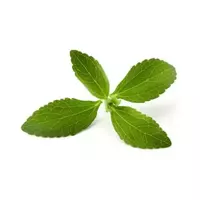Stevia grass

In recent years, scientists have observed a steady interest of modern humans in healthy eating. And there is nothing strange about this, because many dietary supplements obtained artificially can really harm human health. Take, for example, ordinary sugar or synthetic sugar substitute, which many seek to replace with something useful. And here we are helped out by a plant that has been quite popular lately - stevia grass.
This perennial sometimes reaches a height of about a meter, but still the size of the stevia grass directly depends on external conditions. For example, a plant grown in a pot is unlikely to be more than 40 centimeters, while in the ground it will easily exceed such parameters.
However, this grass is known not for its appearance, but for the presence of certain properties of stevia, in particular for its increased sweetness. So, the leaves of this plant are much sweeter than absolutely any type of sugar, while they are completely safe, since they do not have countless calories, which is typical for the aforementioned white matter, and a negative effect on the human body, as in the case of sweeteners of artificial origin.
Today, stevia grass is widely used not only in the industrial production of many food products, but also at home. Quite often it is added to candy, chewing gums or desserts. Crushed fresh or dry stevia leaves are great for sweetening coffee, tea or soy sauce. This weed is good as a component for marinating some types of vegetables and drying marine delicacies. In addition, some manufacturers add stevia herb extract to toothpastes as well as oral care fluids.
Stevia composition
It has been proven that regular consumption of this green plant not only does not cause adverse consequences, but, on the contrary, helps people in the fight against many ailments. The fact is that stevia contains a number of substances we need: polysaccharides, fiber, plant lipids, glycosides, pectin, vitamins, essential oils and much more.
By the way, the extraordinary sweetness of this plant is due to the presence of stevisiodes in stevia, which are many times sweeter than granulated sugar and belong to phytosteroids - substances responsible for the synthesis of hormones in the human body.
Stevia benefits
Today you can find huge lists of diseases in which this plant acts as a drug. In particular, the benefits of stevia are obvious in the treatment of periodontal disease, angina pectoris, caries, insomnia, various types of allergies, eczema, abundant dandruff, psoriasis and a mass of other diseases.
In addition, substances in the composition of stevia have a beneficial effect on all organs of the human body. With its regular use, radioactive substances are naturally eliminated from the body and the aging process slows down. Fans of this plant claim the benefit of stevia as an excellent assistant in cancer, in connection with the ability of this grass to stop the growth of tumors.
The harms of stevia
It is gratifying that stevia grass has no contraindications to use. You can eat stevia from a young age: for example, mothers often add a couple of leaves of this weed when cooking compote for their child. Definitely, there will be no harm to stevia for the child's body - exclusively benefits.
stevia 18 kCal herbs
Energy value of stevia grass (Ratio of proteins, fats, carbohydrates - ju):
Proteins: 0 g (~ 0 kCal)
Fats: 0 g (~ 0 kCal)
Carbohydrates: 0.1 g (~ 0 kCal)
Energy ratio (bj | y): 0% | 0% | 2%
 Español
Español Français
Français Português
Português Русский
Русский 简体中文
简体中文 繁體中文
繁體中文 日本語
日本語 한국어
한국어 العربية
العربية Türkçe
Türkçe Қазақ
Қазақ Deutsch
Deutsch Italiano
Italiano Українська
Українська
